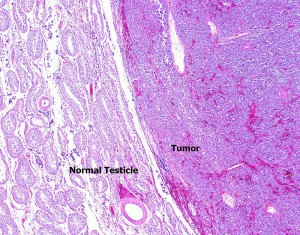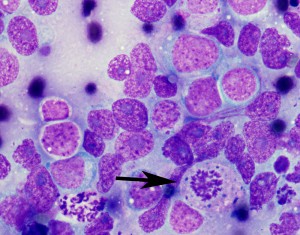As most of you know, giant panda Gao Gao had surgery May 6, 2014, to remove his right testicle after a tumor was discovered by our veterinary staff (see Surgery for Gao Gao). Since that time, we have received a lot of questions about how Gao Gao’s diagnosis was made and what the findings mean for his long-term prognosis. In this blog I’ll tell you about our analysis of the tumor in the Wildlife Disease Laboratories of the San Diego Zoo Institute for Conservation Research and what we know about the tumor in giant pandas and other animals.
After we received Gao Gao’s testicle in the laboratory, parts of the tumor were processed and stained for examination under a microscope. From this, the veterinary pathologists gathered clues from the arrangement and distribution of tumor cells, features of individual tumor cells, and the frequency of tumor cell division and invasion into adjacent normal tissues.
We also used a specialized technique, immunohistochemistry, to determine if the tumor was making substances characteristic of one particular cell type or another. All of this information was synthesized to determine the tumor cell type and if the tumor was completely removed.
In Gao Gao’s case, the evidence supports a diagnosis of seminoma, which is a tumor arising from the germ or sperm-producing cells. In addition, there was no evidence in the surgically removed tissues of tumor spread beyond the testicle. In domestic animals, seminomas are common in older dogs, and they are usually completely cured by surgery. However, in other species such as humans, a higher percentage of seminomas will metastasize (spread) to other organs without additional treatment such as chemotherapy.
So what does this mean for Gao Gao? The answer is that we can’t tell for certain if his tumor has been cured by surgery or if there is a small chance that it could reoccur at a later time. This is a common problem for pathologists who work with endangered animals, because very few tumors will ever be observed in these species, whereas it is easy to gather information on tumor behavior in dogs and humans where thousands of cases can be studied over time.Despite this uncertainty, we are very hopeful that Gao Gao’s tumor will behave more like a seminoma in dogs. In 1997, a seminoma was found in 26-year-old giant panda Hsing Hsing, from the National Zoo, and treated by surgical removal. Hsing Hsing died two years later from kidney disease, and there was no evidence of any remaining tumor at his necropsy. We have had an opportunity to compare the microscopic sections of Hsing Hsing’s tumor with the samples from Gao Gao, and they are very similar.












